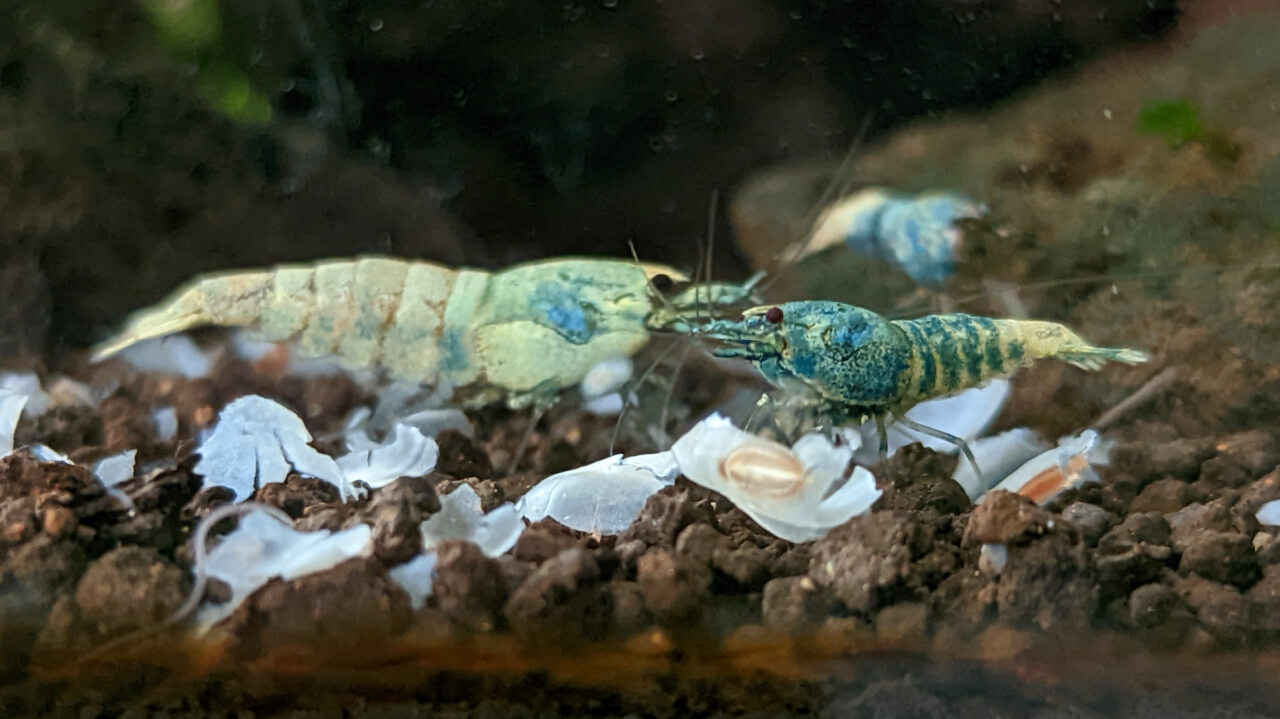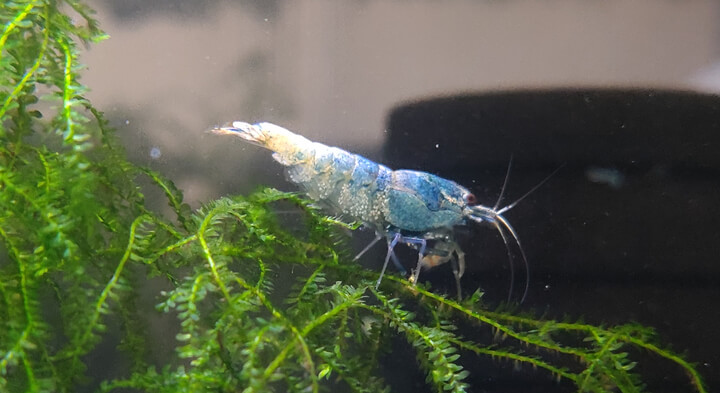Water parameters
- pH
- 5.5 - 6.5
- GH
- 4 - 6
- KH
- 0 - 1
- TDS
- 100 - 180
- Temperature
-
20 - 25 °C
68 - 77 °F
Facts
Difficulty level- Medium
Lifespan- 1 - 2 years
Origin- Taiwan
Adult size- 30 mm / 1.2 inches
Blue Bolt shrimp are a type of Taiwan bee in the Caridina species originating from Taiwan. They normally have a deep sky blue body, sometimes with a soft gradient into a cloudy white tail.

An adult can grow to be around 3 cm (1.2 inches) in size.
Grades
High grade shrimp are usually a strong, consistent sky blue colour all over. This high a grade is sometimes known as the Extreme Blue Bolt, and they’ll have very little to no white patches.
Medium grade will normally have some darker and lighter patches, mostly near the head.
Low grade is likely to be about half white and half blue, with fairly patchy and inconsistent colouring, looking similar to a Steel Blue.

Care
Blue bolt shrimp can be hard to keep, as like most other Caridina types, they require a fairly specific range of water parameters to keep healthy. However, if you can give them the perfect parameters, a Blue Bolt should live for up to 1-2 years.
It’s important to keep the KH in particular as close to the 0-1 range as possible or there’s a risk they’ll struggle to molt safely.
This type also prefers to be in more acidic water, being happy all the way down to around 5.5 pH. However, keeping the pH stable with such a low KH can be difficult, which is why it’s highly recommend to use buffering or active substrate. This will stabilise the pH swings throughout the day as there are no/low carbonates in the water itself, which would normally do this for you.
You don’t always need a heater to keep Blue Bolt shrimp warm throughout the year, as long as your room will stay around 20 °C (68 °F) during the colder months. If you get very bitter winters, or if your shrimp tank is next to a window, then you should definitely consider getting a heater for your aquarium.
A general rule for freshwater dwarf shrimp is to have a minimum tank size of 5 gallons (19 liters), but 10 gallons (38 liters) and larger is recommended.

Diet
Most freshwater dwarf shrimp will eat the same types of foods. They’ll spend the vast majority of their time moving around the aquarium in search of tiny bits of food like biofilm and algae, which can grow on almost any surface. If your tank is mature and heavily planted, they’ll probably have plenty of natural food to eat already.
If you’re not sure they’re getting enough to eat, there are lots of different foods for your shrimp like algae wafers, bee pollen, shrimp pellets, blanched vegetables, etc.
Giving your shrimp a variety of different foods will make it more likely they’re getting all the nutrients they need to thrive.
Tank mates
These are much easier to keep in a tank with other Caridina types as they all prefer more acidic water. You’ll also be able to get a wide range of interesting hybrid shrimp if you allow the different types to breed together.
It is possible to keep Blue bolts with other Neocaridina, but keeping both types of shrimp happy will be a more difficult balance.
Find the ideal water parameters and compatible tank mates for Blue Bolt shrimp.
It’s sometimes possible to keep smaller fish like Neon Tetras in a shrimp tank. There is a risk that the fish will see your shrimp as food however, so you should make sure they’ve got plenty of hiding places if you wanted to try this. The risk of being eaten is much higher for baby shrimp, so if you’re planning to breed your shrimp it’s highly recommended not to have any fish in the same tank.
Breeding
There are a few common variations of Blue bolts that can come around from breeding them together or with other Caridina types. Blue steel is one example, which have the head of a Blue bolt but a blunt transition into a strong white body. Shadow Mosura is another which looks similar but has a distinctive dark black spot on the top of their head.
Blue bolts can breed with any other Caridina and will normally ensure the offspring has a healthy amount of blue on their shells.
If you’re trying to start up a colony, you can read our guide on how to breed shrimp for tips and suggestions.


